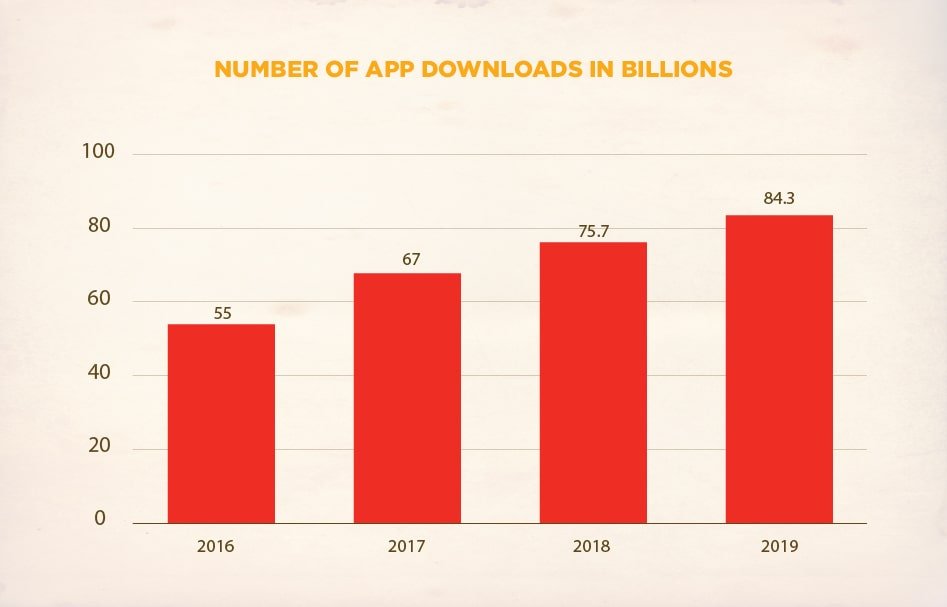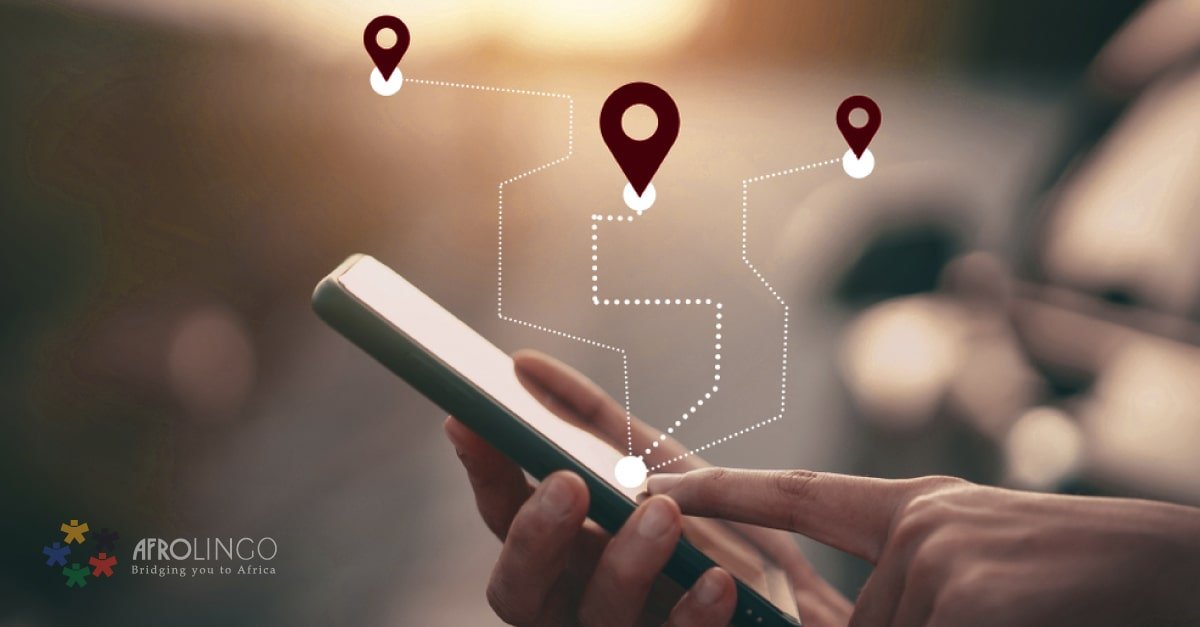The mobile app industry is booming both globally and across South Africa.
On a global scale, the mobile app market is now exceptionally large and continues to grow day by day. Just have a look at the numbers of app downloads from the Google Play Store worldwide over the period from 2016 to 2019, and you’ll be left almost speechless.
The annual number of app downloads from the Google Play Store worldwide from 2016 to 2019 (in billions)

So, what about Apple?

Mobile App Industry in South Africa
Fortunately, South Africa is riding the same wave, with the country’s mobile app economy noticeably on the rise.
The current growth of mobile application usage in South Africa can easily be attributed to a number of factors. They include low mobile data usage costs, a growing adaptation of smartphones, an increase in mobile application usability, and the advancement of network technologies. The net result is the rise of a “mobile-first” craze all across the country.
What about figures? Okay, take this. Revenue in the Apps segment in South Africa amounts to USD 39 million in 2020. Also, this revenue is expected to show an annual growth rate of 5.8%, resulting in a market volume of USD 48 million by 2024, according to Statista.
Why Mobile App Localization?
As a mobile app developer in South Africa, or anywhere all over the world, there’s no room for finding any middle ground between localization and no localization.
Localizing your mobile apps has become a necessity if you wish to make the most out of your mobile app products. Forget that releasing your app in just one language will take you anywhere close to success in a country where the constitution recognizes 11 official languages.
But, still why should any mobile app developer outsource app localization services? Suffice it to mention 3 reasons!
1) Enhance Global User Experience
Even though 90% of mobile devices activity currently occurs in apps, not browsers, yet we still need to ask why users usually download most apps and delete them within minutes. The answer lies in the magic of mobile app localization. In truth, when you professionally translate your mobile app into your users’ native language and localize it to reflect their specific culture, you provide a meaningful user experience for your international customers.
2) Increase App Store Searchability
Thankfully, Google Play Store and iTunes App Store make it possible for you to localize your mobile app listing to facilitate discoverability and readability for global users. Consequently, your app will be found by more and more consumers who use keywords in their language and will be more likely to download when they read a welcome message in their own mother tongue. Together, these two advantages can add up to a 767% increase in downloads.
3) Increase App Downloads Overseas
Let’s refer to objective statistics. A study by Distomo has revealed that mobile apps localizing leads ─ within only one week from the release of the localized app ─ to 128% more downloads per country and a 26% increase in revenue for each country added via app localization.
Similarly, a study by Statista reveals that 11.3 billion apps were downloaded in the United States in 2017, while other countries like India had 12.1 billion and China had a formidable 79.3 billion downloads.
Therefore, it goes without saying that mobile app localization makes it possible for mobile app developers to access global markets. This results in increasing your downloads and boosting your sales.
The Process of Mobile App Localization
At AfroLingo, we’ve developed, over the past 12 years, a special multi-step process that gives us the best results when it comes to taking our clients’ mobile app products to multiple audiences in South Africa and on a global scale. Let’s dive in.
1) Market research and Buyer Persona
Like every good work, it all starts with getting to know who the audience definitely is. We start with analyzing our client’s mobile app product along with the market (or markets) they’re targeting ─ both local and overseas.
Our market research always takes into account a number of important elements, including the competition and the kind of customer experience competitors provide for users. Our objective is to see whether our client can provide a better customer experience without offending local customs.
We work hard on creating buyer personas that describe the mobile app’s target audiences. This includes such aspects as demographics, interests, preferences and other buying behaviors. Then we give all these details – along with a general idea about the product’s end users – to our localization team to make it possible for them to choose the right style and terminology for the localized app.
2) Prepare Mobile App
This step contains many details for preparing the mobile application, including space and layout. We also focus on many other aspects, including:
- Interface. The key idea here is our awareness that what works for one country may be unattractive for another. Each culture has its preferences.
- Servers. Here, we have to check and decide if working with local servers can avoid delays and disconnections.
- Design. Our experts have to select the fonts, colors, images and graphics that adapt easily to local traditions. We also have to ensure that the client’s source content is multiple languages ready and that the app code is written to allow the client to create versions of their product in other languages easily and cost-effectively.
3) Selecting the Right Operating System
Android or iOS or both? At this point, we work with the client taking his budget into account. Our job here is to help our client cut through the noise and gain visibility with the variety of audiences, communities, languages and cultures in South Africa.
4) Building The localization Team
We rely on our solid team who conducts the job in its various areas ─ from app developers to programmers, linguists, translators, legal consultants as well as marketing and localization specialists.
5) Leveraging the Translation Management System
Since most of the translation team members may come from different countries, we work with the latest translation management system (TMS) which helps us save time and money. This high-tech TMS helps us do the following:
1. It steers the content flow across the various stages of the localization process, guaranteeing that all information related to the project is carefully tracked and thus streamlining the entire localization process.
2. It makes it possible for us to import and export resource files automatically ─ a step that saves a lot of time.
3. It sends notifications to the team members to keep them updated and to identify tasks in their early stages, thus providing full control over the project.
6) Preparing and Communicating with Translators
While our engineers are preparing the code for localization, we work hard on communicating with translators to give them as much context as possible that would enable them to fully understand the source text of our client’s mobile app. We also provide translators with comprehensive reference materials, such as translation glossaries and style guides.
7) App Store Optimization Strategy
Here comes the step of making the mobile app attractive both for smartphone users and search engines. As we’re fully aware that the higher the app ranks in the app store, the more chances it will have of getting downloaded by users, we usually do the following:
- Our experts research the right words and optimize titles, subtitles and app descriptions, using the right keywords that are relevant to the app.
- Our experts will work on the mobile app’s visuals, with special focus on optimizing the app’s logo.
- Our experts always ensure that photos of the localized app are added instead of using the original ones. They also keep some resources to create a preview video for the mobile app, which will certainly help increase downloads.
8) Marketing, Marketing and Marketing!
Most importantly, we work with our client on a localized marketing strategy that will increase the app adoption rate in the new markets they aim to target.
Our expert linguists are versed in tailoring the client’s message for the new audiences who certainly have different buying habits and sets of values.
Our marketing experts focus on explaining the advantages ─ rather than the features ─ of using the client’s mobile app in an engaging lucid language.
Depending on the client’s goals and budget on a case-by-case basis, our experts work with the mobile app developer to choose between adopting a single global marketing strategy adapted to local markets, or adopting a set of multiple local strategies that mix personal approaches with the brand image.
9) Translation Testing
Then, we begin the on-device localization testing. Our localization testers, who should have full command of the new language, will thoroughly test the mobile app to catch all the localization problems that we might have missed the first time around. They also check the quality of translation, see if the text fits on the page, and find out the places where the app might be offensive to local culture.
10) Launch
After test-driving the translation, you launch your mobile app to your new audience.
How to Choose your Mobile App Localization Partner?
Definitely the labor division theories still apply!
Regarding mobile app development as your strong point, it would be great if you leave the specialized task of mobile app localization to a proficient provider who should have the experience, resources and tools to do it fast, efficiently and professionally. This partner will need to have the following advantages:
- Proven experience in the field of mobile app localization.
- A team of experts versed in translating mobile app content.
- Advanced localization tools and platforms.
- Reasonable turnaround time.
- Rigorous quality control process.
Why AfroLingo?
Since 2008, we’ve been delivering premium app localization services that helped hundreds of top-notch mobile application vendors to grow their mobile user base across a wide variety of languages and communities in South Africa.
In a world that’s going more and more mobile, we’ve been, over 12 years, relying on our experts to deliver professionally localized content and app elements that provide end-users across South Africa with the most convenient, user-friendly experience.
From app resources gathering to layout, context, testing and app store optimization (ASO), our highly skilled team of experts always ensure perfect local language translation of the mobile app in all languages, across multiple platforms, for any market while maintaining optimum usability.
Should you wish to take your mobile app to audiences who speak various languages across South Africa, contact us today for a free quote.


